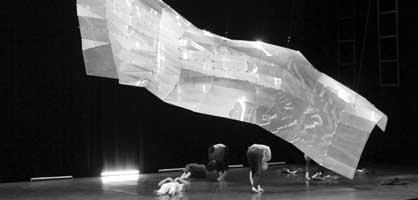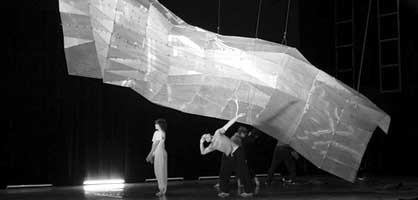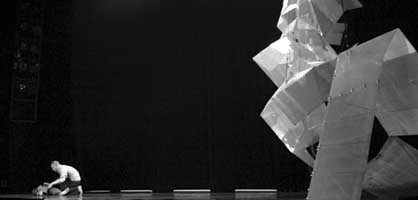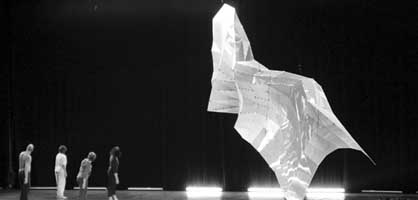|
|
| home > files |
| Stage
set design for California An interview with Ammar Eloueini Melissa Urcan |
| California
is a dance performance piece developed by the choreographer John Jasperse
and performed by his company. As opposed to creating a back-drop or
immobile form for the stage, the set was designed as a morphing structure
that allowed the dancers to engage directly with the piece. Through
modeling surfaces versus engineered structures a surface-form was created
allowing for flexibility. Creating the set as something geometrically
and spatially changing, also being an element of the performance, allowed
easier manipulation as a surface as opposed to a structure. Movement
of the performers was emulated and adopted through the set. The objective
was to work with how the dancers affect space, not only how the set
could be reconfigured by dancers, but how the set could actually affect
the dance. The design was modeled from a complex computer generated
geometric surface. Using a basic fabric pattern layout, the design was
unfolded into individual segments that could work as individual pieces
that together formed the surface. The primary material is polycarbonate
that maintains translucency and reflectivity so the piece absorbs and
diffuses light. Zip-ties secure the pieces allowing for flexibility
and ease of construction. This set can be created in hours, and broken
down in hours, being packed into suitcase-sized boxes to be easily re-erected
elsewhere. |
[28feb2004] | |||
| MELISSA
URCAN: When did you first meet John Jasperse? AMMAR ELOUEINI: I met him almost three years ago in Chicago at the MCA (Museum of Contemporary Art Chicago) where he presented Giant Empty. I was invited by the museum for a round table discussion about the piece after the performance. After talking with John we decided to have breakfast the following day and eventually ended up back at my office. I showed him some of my projects and he was interested in what I was doing. We talked about the idea of working together, but not about any specific project. It was two years later when he contacted me with something in mind. He was working on a performance and wanted to see if a collaboration was possible. What did you know about his performances before you met him? Not that much really. I was given a video from the museum before the round table discussion. The performance was unique, particularly the set as they used an inflatable floor which created a fluctuating ground. I thought this was interesting as dancers primary reference point is the floor, and to have it changing as part of the performance was intriguing.  Did he work with architects before to design his sets? No, he used stage set designers which is somehow a different approach. Recently there have been examples of this architect/choreography collaboration as seen through works of Zaha Hadid and Gehry working specifically for the stage. It was perhaps John thinking outside of the more conventional history of set design to bring in an architect for this project. And had you designed stage sets before this piece? No. I had taken an elective in stage sets through architectural studies in France, which was interesting, but I had pretty much left it there. When the project started, what did John bring to the table as far as his plans for the set? He had specific ideas of what it could be from seeing my Culture Information Center project in New York. He came with images of a destroyed warehouse on a pier in New York City where the steel structure had melted after a fire that reminded him of my NY project, and he has this idea for a set. We had a long conversation about it in Paris while he was in residence in Lyon. This led to more discussions and the collaboration began.  How developed was his performance at this time? Had you seen any part of it? I spent a week with the dancers in Lyon during their rehearsals. There were certain pieces of the performance worked out at this stage, but it was clearly a work in progress. Having never worked with a choreographer to design a set, how did you approach this design? I didn't have any preconceived ideas. I was essentially trying to capture his vision-trying to adapt what he was doing. Were you trying at this point to keep with his ideas from your NY project? This type of 'melting' space? In the beginning, yes. But the more we talked about it we realized early on that there were constraints that had to be dealt with. Primarily time, as we started working together in August and the premiere was to be in November-so we only had three and a half months to design and build the set. There was also the aspect of shipping from one point to another, as the set was going to be built in Chicago during a residency John had at the MCA in September, but the premiere was in Cannes, France. The set not only had to be built quickly, but it had to be mobile-light and easily transportable. Finally, cost was a major issue as they had a tight budget. Taking these constraints into consideration, what were your next steps for the design? After this week in France, I had a better idea of the dancers and choreography and I began to guess on the computer. Guessing? Which part? Choreography? Stage? Design? A combination of the performance and the material we would use within our constraints-the budget issue. There were no immediate solutions. He was looking at tubular, chaotic structures representing themes such as weather changes and the relationships of the different dancers. I was initially investigating something engineered, almost a building type in reaction to his ideas of the NY project which was itself highly engineered. This was when I realized the fact that there is the difference not only through durability or permanency, but that the stage set needs less complexity. This idea was present of something moving and changing on the stage that counteracts the notion of engineering itself. I was hoping to integrate this notion of movement and change into the set.  And there was an element of change inherent in the performance, correct? As the performance was at this point still a work in progress. This became more apparent as certain dancers left the company and new dancers started coming in. Initially John was very depressed at the direct influence of certain dancers leaving, at the same time there was a new source of creativity-an ability to perceive the reality of what the performance was evolving into. I was trying to capture this emotion in a way, as part of the work. I began to question how the set could represent chaos, change and reconfiguration as was the actuality of the performance and environment itself with a new team, people leaving, etc. For myself, I began to think of this change as having a place within the stage set design or how a set could be specifically not static, or in fluxes, and express movement. A figure that can reconfigure itself. You were imaging this change and flexibility through the physicality of the set? Through the overall design? In the way we perceived what the stage set could be; how it could be reflecting, fluxes, movement, morphing in space. There was an initial look at tubular, wire-frame structures. Through representation on the computer we started to think of how the structure could be designed or approached as a surface. Through modeling surfaces versus tubular structures we decided that a surface was the best choice as it allows for change. Also, the idea of the set as something geometrically and spatially changing, which was an element of the performance, would be easier to manipulate as a surface as opposed to a structure. In this way we could adopt some of the movement-how the dancers affect space, not only how the set could be reconfigured by dancers, but how the set could actually affect the dance. It became a surface-structure, capable of morphing in time and space.  An initial surface form was therefore decided upon, how was this further developed as a set design and its integration with the performance? Three weeks later in September, the company was in residency in Chicago. I suggested we stop looking at images and build a full scale mock-up. I modeled a complex computer generated geometric surface and tried to determine the best way to create it. Using a basic fabric pattern method as inspiration, I unfolded the geometry into a two dimensional layout that could be constructed into a three dimensional structure. We did it cheaply using corrugated plastic costing only $300- being constructed in only a day and a half and put together with packing tape. John was interested in what that is, something that has specific configurations from 2-D to 3-D. He integrated this idea of unfolding into his performance-the surface form was integrated. How did John react to the initial set? As he had something present, it initially became a type of totem in the space that they were dancing around. The dancers were too respectful of it, not engaged with the piece. I interjected at this point emphasizing that it was only a mock-up. I encouraged the dancers to play with it as it wasn't a "finished" piece. The dancers began to pull it apart, creating a type of release. The piece unmade became more interesting as the dancers adopted it-the surface-rather than me designing the possibilities of what they might do. So essentially you were handing over the design at this stage? I wanted to see what they could or would do with it-more than the piece as a type of sculpture or static stage. I was interested in stepping away to let John adapt it and reconfigure it. There was a small crisis as John really felt that I should keep participating. I felt it was not up to me to decide on these reconfigurations, but to allow the dancers to create and decide what would happen. I was trying to give interaction versus imposing something onto the performance as a choreographer would do. Why did you feel that you did not want to become more involved? In many ways I was involved, but I wanted John to be more engaged. He was too respectful of the piece, as well as were the dancers becoming constrained to the design. I wanted them to adopt it and essentially forced John to become directly involved with the set. There was an involvement through lack of involvement. What were the final design decisions, from your standpoint, and output of the set at this stage coming out of the Chicago residency? The material was decided. We had used an inexpensive plastic for the mock-up, and appreciated the way it not only fit into the budget, but could be constructed in little time. Aesthetically, we both agreed to use polycarbonate that maintained translucency and reflectivity so the piece could absorb and diffuse the light. The technical issues became how to put it together. We eventually adopted zip-ties to secure the pieces which worked perfectly and allowed for both flexibility and ease of construction. At this point the piece could be created in hours, and broken down and packed into boxes to be recreated elsewhere.  After Chicago, John and his company went to New York to finalize the performance without you being present. How did you feel leaving the work at this stage, before the performance itself was finalized, and having the piece in such a form of change? There were rehearsals mid-November and I was not there. They reconfigured the set, but not directly imposing upon it as they still followed the initial surface-form design. More interesting was how they eventually adapted it through having to reconfigure it without my presence. The dancers while in Chicago were more respectful of the initial design as "object." Through working with the piece it became more than an object, and without my direct presence this was perhaps possible. After leaving the piece to transform in this manner, were you surprised when you saw the premiere in Cannes? Not surprised, just curious about how much it had had changed or how close the piece was to the original design. The dancers had previously unfolded the surface in a totally different way than it had come apart at the premiere and were surprised. Far from a specific motive, I am more interested in this flexibility of plan than trying to over-design it. Work with it, let it go, let it live its own, almost as one of the performers on the stage. I am sure every performance will be configured in a different way. There is not one 'right' way or specific configuration, even if one would think this is lack of design. Lack of design? You intended for this? Exactly. An allowance for reconfigurations, slight differences. The performers initially tried very hard to make it predictable. After time perhaps they will accept this unpredictability, as the more put together, more accurate the set is, the less interesting it is going to be. Melissa Urcan urcan@hotmail.com |
||||
|
>
DIGIT-ALL STUDIO |
||||